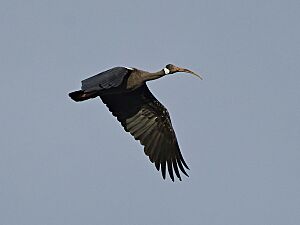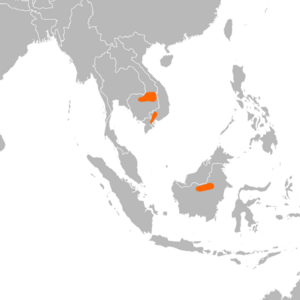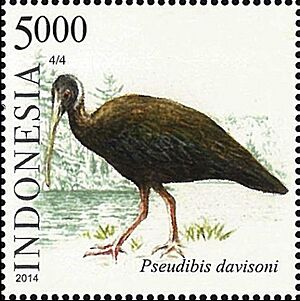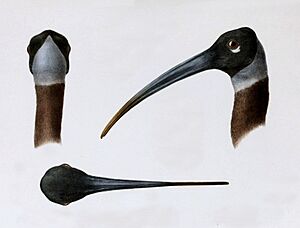White-shouldered ibis facts for kids
Quick facts for kids White-shouldered ibis |
|
|---|---|
 |
|
| Adult bird flying over a forest and rice field mosaic in eastern Cambodia | |
| Conservation status | |
| Scientific classification | |
 |
|
| range | |
| Synonyms | |
|
The white-shouldered ibis (Pseudibis davisoni) is a large bird from the Threskiornithidae family. It lives in small parts of Southeast Asia. This ibis is one of the most endangered bird species in that area.
Contents
About This Ibis
The white-shouldered ibis was first described in 1875 by a scientist named Hume. He named it Geronticus davisoni after his bird collector, William Ruxton Davison. Later, scientists noticed it looked similar to the black ibis. So, they put both birds in the same group, or genus. For a while, some thought it was just a type of black ibis. But now, it is known as its own separate species.
What Does It Look Like?
Adult white-shouldered ibises stand about 60–85 cm (24–33 inches) tall. Males are a bit bigger and have slightly longer beaks than females.
Their feathers are brownish-black. Their wings and tail are shiny blue-black. The head is bare and slate-black, but some say it can look blue or white. They have a clear bluish-white band of bare skin around their neck. This band is wider at the back and thinner at the front. It can sometimes look completely white. Their legs are dull red, and their eyes are orange-red. Their large, curved beak is yellowish-grey.
The white-shouldered ibis gets its name from a white patch. This patch is on the upper part of its neck and chin in some birds. When they fly, these patches can look like "white shoulders." Also, in flight, you can see a bright white patch on their wings. When their wings are closed, this patch looks like a thin white line.
This ibis looks a lot like the red-naped ibis from India. But the white-shouldered ibis does not have the red bumps on its neck. It is also a bit bigger and stronger. Its neck and legs are longer. Its tail also looks shorter and points downwards, not straight like the black ibis.
Young ibises have dull-brown feathers. They have a tuft of brown feathers on their bluish-white neck. Their eyes are grey-brown, and their legs are pale yellow with dull white feet.
These birds make loud, sad calls. Some people describe them as "weird and unearthly screams." When they are protecting their area, they make hoarse calls like "errrrh" or "errrrrroh." They also make honking screams like "errrrh owk owk owk owk owk." During mating, they make a loud, harsh "klioh klioh" sound.
Where Do They Live?
This ibis used to live in many more places in Southeast Asia. It was found from Myanmar to Thailand, Malaysia, Cambodia, Laos, Vietnam, and even into China. Now, there are very few of them left. They live in small, separate areas. These areas are in northern and eastern Cambodia, southern Vietnam, southern Laos, and East Kalimantan.
Cambodia has the most white-shouldered ibises. About 85-95% of all these birds live there. The biggest group in Cambodia is in the Western Siem Pang Important Bird Area. Other places in Cambodia with many ibises include Kulen Promtep Wildlife Sanctuary and the Mekong River.
The white-shouldered ibis is now mostly gone from Thailand, Myanmar, and southern China. It is very rare in Indonesian Borneo and southern Laos. Thailand used to have many of these birds, but none have been officially seen there since 1937.
This ibis likes to live in lowlands. It has been seen in different places. These include dry forests, edges of seasonal pools (called "trapaengs"), old rice fields, grassy areas, and along rivers. They also like gravel and sandbanks when river levels are low. In Indochina, dry forests seem to be the most important home for them.
These ibises often use areas shaped by traditional farming. For example, local animals like cattle and water buffalo graze and walk through forests. This creates open spaces where the ibises can find food. Also, these animals wallow in mud, making seasonal pools. These pools are important for the ibises. This means the ibis might rely on humans to help create their homes. This is especially true because many wild animals that used to create these spaces are now rare.
Life and Habits
What Do They Eat?

Unlike other wading birds that live in the same areas, the white-shouldered ibis mostly looks for food on land. It does not usually feed in open water. It prefers to find food in muddy seasonal pools with short plants (less than 25 cm tall). It also feeds on the ground in dry forests, especially where the ground is bare. Sometimes, it feeds in old rice fields or along rivers with lots of mud and sand.
During the breeding season, it almost only feeds at seasonal pools. This is probably because many small animals hide in the cracks of the dry mud. This means there is a lot of food for their chicks. The ibis has a special curved beak that helps it poke into these cracks to find hidden prey. Other birds like cattle egrets and Chinese pond herons sometimes follow the ibis to steal its food.
Ibises feed alone, in pairs, or in family groups. Groups of up to 14 birds have been seen. They form much larger groups in the wet season (when they are not breeding) than in the dry season.
Their diet includes small creatures like worms, mole crickets, leeches, and insect larvae. They also eat amphibians like Paddy Frogs and other small frogs. Sometimes, they eat eels. Frogs seem to be a big part of their diet. The type of food they eat can depend on how wet or dry the ground is. Dry ground seems best because there are many large amphibians there. There are also stories that this ibis eats fruit, but this is not proven.
After it rains, ibises use forests and fields more for food instead of pools. This is because the food in the pools spreads out more when there is more water.
Reproduction and Life Cycle
The white-shouldered ibis breeds alone. In Cambodia, they build nests from December to April. This is during the middle to late dry season. They nest in the tops of tall trees, usually 10-25 meters (33-82 feet) high. They use twigs and fresh leaves to build their nests. Both parents keep adding material to the nest. They might even use the same nest for many years. Sometimes, they use old nests made by other large birds.
They lay 2-4 pale blue eggs. The eggs hatch at different times. The female sits on the eggs for 28–31 days. After hatching, the young birds stay in the nest for 26–40 days until they can fly.
Other Behaviour
When they are not breeding (in the wet season, July–October), white-shouldered ibises gather in groups. They roost (rest) together in trees. Large groups of up to 185 ibises have been seen feeding together in open areas like old rice fields. They also feed at seasonal pools, which have higher water levels in the wet season.
This ibis usually stays in one area. But in the wet season, they might move a short distance, just over 5 km (3 miles), between their resting and feeding spots. In Cambodia, they move from wet areas in the forest to drier forest ground. This is probably because it's easier to find insects on dry land than amphibians in the pools. In Borneo, they move along big rivers like the Mahakam River when water levels change. This helps them find exposed riverbanks to feed on. Big forest fires can also make them move to unburnt areas.
Threats to Their Survival
The white-shouldered ibis is one of the most endangered birds in Southeast Asia. The biggest dangers to these birds are:
- Habitat loss: Wetlands are drained for farms and plantations. Forests are cleared for new buildings and roads.
- Changing land use: New ways of managing land, like giving land to companies, can destroy their homes.
- Dams: Proposed dams on rivers like the Mekong could harm ibis groups.
Most of the ibises in Cambodia (where most of them live) roost outside protected areas. This is a problem because these important resting places are not safe. Ibises often live close to human settlements because they rely on human activities to create their habitats. But this also makes them more likely to be hunted.
The ibis population along the Mekong River is very vulnerable. This is because they use both river and dry forest areas. This means they might meet more people who exploit nests, like forest workers and fishers. Also, ibises might compete with humans for food like frogs and eels during the dry season.
Another threat is modern farming. If farmers stop using traditional methods like grazing animals, the ibis's habitat could be harmed. Animals like cattle help keep clearings and seasonal pools open for the ibises to feed. If these traditional methods disappear, plants might grow too tall around the pools, making them unsuitable for the ibis. This is especially important because many wild animals that used to do this are now gone.
People sometimes take ibis eggs and chicks from nests for food. This can cause nests to fail. However, natural predators like crows, civets, and martens also cause many nest failures, especially when the eggs are laid or the chicks are very young. Sometimes, strong winds can even blow chicks out of nests.
Forest fires, like those caused by El Nino, have also harmed ibis populations. Fires destroy their homes and can change river conditions, making it harder for them to find food.
How They Interact with Humans
This ibis seems to rely a lot on human farming activities to keep its home suitable. Because of this, it lives closer to people than other similar birds. It might even roost and nest in trees near rice fields, even when people are working there. However, the ibis is probably more attracted to the farming areas for food, rather than to humans themselves. People sometimes hunt this ibis for food, but it is not traded for money.
Only one white-shouldered ibis has ever been kept in captivity. It was brought to Thailand from Cambodia in 1989 and lived in a bird park near Bangkok in 1990.
Conservation Status
The number of white-shouldered ibises dropped sharply in the late 1900s. Because there are so few sightings, their population is small, and their homes are still being lost, the IUCN has listed them as Critically Endangered. This means they are at a very high risk of becoming extinct.
There are about 1,000 white-shouldered ibises left in the world. About 670 of these are adult birds. In 2013, a count in Cambodia found 973 ibises. In Indonesian Borneo, there are an estimated 30-100 birds.
Name Origin
The scientific name davisoni honors William Ruxton Davison.



